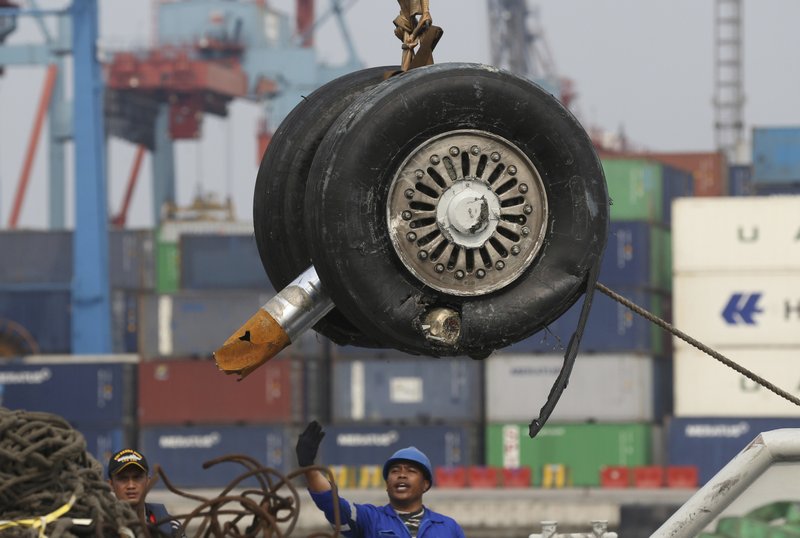JAKARTA, Indonesia -- The U.S. Federal Aviation Administration issued an emergency airworthiness directive on how to handle erroneous data from a sensor that investigators believe malfunctioned on a new Boeing jet that plunged into the sea in Indonesia, killing all 189 people on board.
The directive gives regulatory weight to Boeing's safety bulletin that it sent to operators of Boeing 737 MAX 8 and MAX 9 planes based on findings from the ongoing Indonesian investigation into the Oct. 29 crash of a Lion Air jet. FAA directives are usually followed by other airline regulators internationally.
The FAA said erroneous data from the Angle of Attack sensor, which helps prevent the plane from stalling and diving, could cause flight crews to have difficulty controlling the airplane and lead to "excessive nose-down attitude, significant altitude loss, and possible impact with the terrain."
The directive instructs airlines to make specific changes to flight manual procedures for responding to the problem. Boeing's bulletin said it was directing flight crews to existing guidelines.
Indonesian investigators on Wednesday said the sensor was replaced on the Lion Air plane the day before its fatal flight and may have compounded other problems with the aircraft.
The 2-month-old Boeing 737 MAX 8 crashed into the Java Sea 13 minutes after takeoff from Jakarta. Both that flight and its Oct. 28 flight from Bali to Jakarta had erratic speed and altitude shortly after takeoff.
On Wednesday night, Lion Air aborted a flight when one of its planes damaged a wing tip when it struck a lamp pole before takeoff from Bengkulu. The airline faulted the airport's aircraft movement control personnel who directed the plane from the apron to the taxiway.
Indonesia's National Transportation Safety Committee earlier this week had said the plane that crashed had a malfunctioning airspeed indicator on its last four flights, based on analysis of the flight data recorder. Chairman Soerjanto Tjahjono said the airspeed indicator and sensor problems are related.
Lion Air's first two attempts to address the airspeed problem didn't work, and for the jet's second-to-last flight the Angle of Attack sensors were replaced, Tjahjono said.
On that Oct. 28 flight, from Bali to Jakarta, the pilot's and copilot's sensors disagreed by about 20 degrees. The plane went into a sudden dive minutes after takeoff, from which the pilots were able to recover. They decided to fly on to Jakarta at a lower-than-normal altitude.
On the fatal flight, the plane hit the water at very high speed after the flight crew had been cleared to return to the airport several minutes after takeoff.
"The point is that after the [Angle of Attack sensor] is replaced, the problem is not solved but the problem might even increase. Is this fatal? [The National Transportation Safety Committee] wants to explore this," Tjahjono said.
Airline safety experts said pilots are trained to handle a plane safely if those crucial sensors fail and backup systems are generally in place as well.
There are audio signals and physical warnings that can alert the pilot to malfunctioning equipment or other dangers, said Todd Curtis, director of the Airsafe.com Foundation.
"They should have been completely engaged in what was going on inside that cockpit, and any kind of warning that came up, they would have been wise to pay attention to it," Curtis said.
Investigators are likely focused on how a single sensor's failure resulted in a faulty command that didn't take into account information from a second sensor, said John Cox, CEO of Safety Operating Systems.
"We don't know what the crew knew and didn't know yet," Cox said. "We will."
Indonesia's search and rescue agency has extended the search until Sunday. Body parts are still being recovered and searchers continue to hunt for the cockpit voice recorder.
Indonesia's transportation safety committee said it had agreed with Boeing on procedures that the airplane manufacturer should distribute globally on how flight crews can deal with the sensor problems.
The flight procedure recommendations to Boeing were based on how the flight crew responded to problems on the Bali-to-Jakarta flight, said investigator Nurcahyo Utomo.
Lion Air is one of Indonesia's youngest airlines but has grown rapidly, flying to dozens of domestic and international destinations.
Information for this article was contributed by Cathy Bussewitz of The Associated Press.
A Section on 11/09/2018

